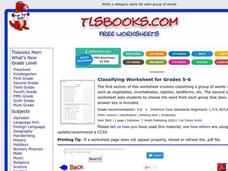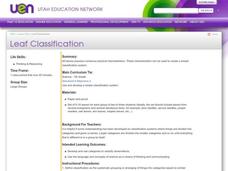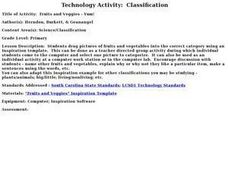Curated OER
Putting Things in Place
In this classification worksheet, students read the words from the word box and then write them under the correct category of 'things that fly,' 'things that are hot,' or 'things that are soft.'
Curated OER
Classifying Pictures
In this classification instructional activity, students examine four different pictures in a row. Students then circle the picture that does not belong with the other three.
Curated OER
Classification
In this classification worksheet, students observe the fingerprints provided. Students decide upon a classification system to use to categorize the given fingerprints.
Curated OER
Make a List
In this classification worksheet, 2nd graders make a list of objects that fly. Students study 7 pictures and list those that fly.
Curated OER
Classifying Life
In this classifying life worksheet, students review the 5 kingdoms of organisms by completing 10 matching and 7 fill in the blank questions.
Curated OER
Kingdoms of Life
In this kingdoms of life worksheet, students complete a graphic organizer by filling in the next 8 classification levels under prokaryotes and eukaryotes.
Curated OER
Describing the Living World
In this living world worksheet, students review classification categories, organism adaptations, and organisms' basic needs. This worksheet has 7 matching, 7 true or false, 2 multiple choice, and 3 short answer questions.
Curated OER
What Animals Are Mammals And Birds?
In this classification worksheet, students will brainstorm animals and list them on the graphic organizer as either a mammal or a bird.
Curated OER
Organizing Life
For this classification worksheet, learners will review vocabulary words associated with the organization of living things which includes kingdom, phylum, class, order, family, genus, and species. This worksheet has 5 fill in the blank...
Curated OER
Using a Flow Chart for Classification
For this flow chart worksheet, students learn to use flow charts for classification of numbers, geometric shapes and animals. Students follow the directions and fill out flow charts to work out 20 answers. This is an online activity that...
Curated OER
What is Classification?
In this classification instructional activity, students describe the difference between Homo erectus and Homo sapiens. Then they define taxonomy and explain what was wrong with Aristotle's method of classification. Students also describe...
Curated OER
The Rock Cycle
In this rock cycle activity, students copy the table illustrated for data and observations of rock samples. Then they examine the rock samples observing the characteristics and the arrangement of grains in each. Students then record...
Curated OER
Classifying
In this classifying worksheet, students observe a group of words, analyze their similar characteristics and then give them a classification. Groups of words include items such as vegetables, reptiles, landforms, conifer trees,...
Curated OER
Fruit Or Vegetable? Sort the Cards
In this sorting worksheet , students color and cut 24 picture and word cards depicting different fruits and vegetables. Students sort the cards.
Curated OER
How Things Taste (Pieces)
In this worksheet, students cut and color 10 foods. Students classify them according to their taste and paste in the right space. This is intended to be used with another worksheet.
Curated OER
What Are They Doing?
In this sorting cut and paste worksheet, learners cut out 6 pictures of children engaged in household tasks. They paste these pictures in a house shaped puzzle, matching them to the correct verb phrase, ie, "washing the dishes."
Curated OER
Bodacious Buttons
First graders graph a data set. Given a set of buttons, 1st graders sort them into categories using specific attributes. They graph the number of buttons in their set based on their attributes using a variety of graphs. Students share...
Curated OER
An Introduction to Dichotomous Keys
Young scholars pretend to be shark biologists employed by the National Oceanic and Atmospheric Administration (NOAA) who have been flown into the coastal city of Sao Luis in Brazil because locals have noticed an unidentified shark at...
Curated OER
Classifying Animals
Second graders identify different types of animals on a two charts titled "Mammals" and "Not Mammals." They listen as the book, "They Call Me Wooly," by Keith DuQuette is read to them. Students are asked what is different about the...
Curated OER
An Introduction to Classification
Sixth graders explore, analyze and study the history of classification systems and the scientific processes that influenced modern classification methods. They evaluate why classification and binomial nomenclature are necessary to the...
Curated OER
Leaf Classification
Seventh graders work together to develop a leaf classification system. In groups, they are given a set of leaves and sort them based on their characteristics. They share their new classification system with the class and answer any...
Curated OER
Fruits and Veggies - Yum!
Students use Inspiration to drag pictures of fruits and vegetables into the correct category. They discuss the name of other fruits and vegetables. They explain why or why not they like that particular fruit or vegetable. Students...
Curated OER
Minerals and Rocks
Students identify and interpret various minerals and discover how to identify and classify them. They identify and discuss how people describe objects and how scientists describe objects. From there, students look at a set of common...
Curated OER
Classified Information - Part 1: Shapes
Third graders investigate how and why scientists use classification. They discuss classification strategies using animals, and as a class fill in a flowchart with their responses. Next, in small groups they cut out a variety of shapes...

























